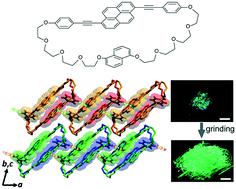当前位置:
X-MOL 学术
›
Mol. Syst. Des. Eng.
›
论文详情
Our official English website, www.x-mol.net, welcomes your
feedback! (Note: you will need to create a separate account there.)
Crystal structure of a 1,6-bis(phenylethynyl)pyrene-based cyclophane that exhibits mechanochromic luminescence
Molecular Systems Design & Engineering ( IF 3.2 ) Pub Date : 2021-09-29 , DOI: 10.1039/d1me00131k Shohei Shimizu 1 , Shakkeeb Thazhathethil 1, 2 , Kiyonori Takahashi 2 , Takayoshi Nakamura 2 , Yoshimitsu Sagara 1
Molecular Systems Design & Engineering ( IF 3.2 ) Pub Date : 2021-09-29 , DOI: 10.1039/d1me00131k Shohei Shimizu 1 , Shakkeeb Thazhathethil 1, 2 , Kiyonori Takahashi 2 , Takayoshi Nakamura 2 , Yoshimitsu Sagara 1
Affiliation

|
Cyclophanes featuring luminophores are considered promising candidates as thermal or mechanical stimuli-responsive luminescent materials. The mechanism of the changes in the photophysical properties on the crystal–crystal or crystal–amorphous phase transitions can be easily clarified, owing to the crystal structure of the cyclophanes. However, in the case where flexible aliphatic chains are introduced to the target cyclophane, the procurement of the crystals suitable for single-crystal X-ray analysis is challenging. Conversely, the introduction of significantly shorter linkers between large π-conjugated groups leads to difficulties in compound purification, resulting in incorrect photophysical properties, particularly in the solid state. Herein, we report the crystal structure of a 1,6-bis(phenylethynyl)pyrene-based cyclophane and mechanoresponsive luminescence. The cyclophane has a naphthalene group as another aromatic group, and the two different π-conjugated groups are bridged by tetraethylene glycol linkers. Single-crystal X-ray analysis revealed that the pyrene and naphthalene moieties form intramolecular π-stacked structures in the crystals, and intermolecular excimer formation of the luminophores was not observed. The arrangement of the isolated luminophore results in light-blue emission with a well-resolved vibronic structure in the fluorescence spectrum. Mechanical grinding induces a phase transition from crystal to amorphous, which was confirmed by the powder X-ray diffraction measurements, and the emission colour turns green. The photoluminescence spectroscopy and emission lifetime measurements clarified that the green emission is ascribed to intermolecular excimer formation. Subsequent thermal treatment recovers the initial light-blue-emissive crystalline state. The crystalline phase is thermodynamically stable, whereas the amorphous state is thermodynamically metastable.
中文翻译:

1,6-双(苯基乙炔基)芘基环芳的晶体结构,具有机械致变色发光
以发光体为特征的Cyclophanes被认为是热或机械刺激响应发光材料的有希望的候选者。由于环芳的晶体结构,可以很容易地阐明晶体 - 晶体或晶体 - 非晶相变的光物理性质变化的机制。然而,在将柔性脂肪链引入目标环烷的情况下,适合单晶 X 射线分析的晶体的采购具有挑战性。相反,在大 π 共轭基团之间引入明显更短的接头会导致化合物纯化困难,导致光物理性质不正确,特别是在固态下。在此,我们报告了 a 1 的晶体结构,6-双(苯乙炔基)芘基环烷和机械响应发光。环芳有一个萘基团作为另一个芳香基团,两个不同的π共轭基团通过四乙二醇连接体桥接。单晶 X 射线分析表明,芘和萘部分在晶体中形成分子内 π 堆积结构,未观察到发光团的分子间准分子形成。孤立的发光体的排列导致浅蓝色发射,在荧光光谱中具有解析良好的振动结构。机械研磨诱导从晶体到无定形的相变,这通过粉末 X 射线衍射测量得到证实,并且发射颜色变为绿色。光致发光光谱和发射寿命测量表明,绿色发射归因于分子间准分子的形成。随后的热处理恢复了初始的浅蓝色发光结晶状态。晶相在热力学上是稳定的,而非晶态在热力学上是亚稳态的。
更新日期:2021-10-06
中文翻译:

1,6-双(苯基乙炔基)芘基环芳的晶体结构,具有机械致变色发光
以发光体为特征的Cyclophanes被认为是热或机械刺激响应发光材料的有希望的候选者。由于环芳的晶体结构,可以很容易地阐明晶体 - 晶体或晶体 - 非晶相变的光物理性质变化的机制。然而,在将柔性脂肪链引入目标环烷的情况下,适合单晶 X 射线分析的晶体的采购具有挑战性。相反,在大 π 共轭基团之间引入明显更短的接头会导致化合物纯化困难,导致光物理性质不正确,特别是在固态下。在此,我们报告了 a 1 的晶体结构,6-双(苯乙炔基)芘基环烷和机械响应发光。环芳有一个萘基团作为另一个芳香基团,两个不同的π共轭基团通过四乙二醇连接体桥接。单晶 X 射线分析表明,芘和萘部分在晶体中形成分子内 π 堆积结构,未观察到发光团的分子间准分子形成。孤立的发光体的排列导致浅蓝色发射,在荧光光谱中具有解析良好的振动结构。机械研磨诱导从晶体到无定形的相变,这通过粉末 X 射线衍射测量得到证实,并且发射颜色变为绿色。光致发光光谱和发射寿命测量表明,绿色发射归因于分子间准分子的形成。随后的热处理恢复了初始的浅蓝色发光结晶状态。晶相在热力学上是稳定的,而非晶态在热力学上是亚稳态的。


















































 京公网安备 11010802027423号
京公网安备 11010802027423号